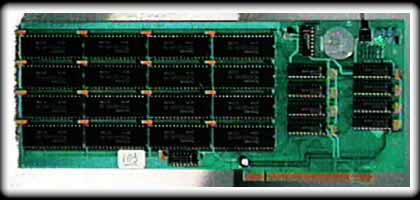
|
Rapier
|
||
RAPIER
 Pictured
here is the Rapier development system inside a PC case.
Pictured
here is the Rapier development system inside a PC case.
This system differs from the Felix system in the following:
| Uses the production versions of the Jaguar chipset (version 1.0). |
| Uses a different connector for the add-on boards |
| Stubulator, timing, video, and DSP circuits all on the motherboard |
Plugged into this board from left to right are the CD ROM board, I/O board, and Cartridge ROM board
 .Pictured
is the CDROM to Rapier Interface. Obviously this board allows the connection
of a CDROM to the development setup (this tell's me that Atari and Flare were
thinking of a CDROM unit from the beginning). It probably connects to the
audio outputs of a external CDROM drive.
.Pictured
is the CDROM to Rapier Interface. Obviously this board allows the connection
of a CDROM to the development setup (this tell's me that Atari and Flare were
thinking of a CDROM unit from the beginning). It probably connects to the
audio outputs of a external CDROM drive.
A thing to note on this board is the addition of a 8pin chip on the left hand side of the board. This is a EEPROM (93C46) chip that is used to save game information on Jaguar cartridges. The Cartridge ROM board doesn't have one of these.
 This
the the I/O board for the Rapier system. Similar to the I/O board used on
the Felix development system (just doesn't have all the connectors and has
a different style motherboard connector).
This
the the I/O board for the Rapier system. Similar to the I/O board used on
the Felix development system (just doesn't have all the connectors and has
a different style motherboard connector).
Has provisions for parallel and serial I/O.
I've only seen one device for Jaguar development that uses serial communication and that is the MIDI adapter board. This board allows the Jaguar to receive MIDI information and play it on the Jaguar during music development.
 .Last
but not least, the Cartridge ROM board. This board uses Toshiba TC551001APL-10
static RAM chips (128k x 8). This board holds 2 megabytes of game information.
.Last
but not least, the Cartridge ROM board. This board uses Toshiba TC551001APL-10
static RAM chips (128k x 8). This board holds 2 megabytes of game information.
It is battery backed-up and has a write protect feature to simulate an actual ROM cartridge.
When I first powered on this system, there was code for the game Troy Aikman Football by Telegames. Unfortunately, memory was corrupted and the game soon crashed. Was not able to recover from this. I think this was the system that Troy Aikman Football was developed on!
